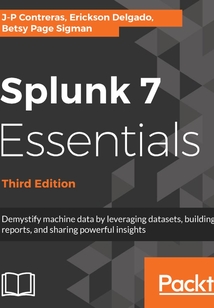目錄(159章)
倒序
- 封面
- Title Page
- Copyright and Credits
- Splunk 7 Essentials Third Edition
- Packt Upsell
- Why subscribe?
- PacktPub.com
- Contributors
- About the authors
- About the reviewers
- Packt is searching for authors like you
- Preface
- Who this book is for
- What this book covers
- To get the most out of this book
- Download the example code files
- Download the color images
- Conventions used
- Get in touch
- Reviews
- Splunk – Getting Started
- Your Splunk account
- Obtaining a Splunk account
- Installing Splunk on Windows
- Installing Splunk on Linux
- Logging in for the first time
- Running a simple search
- Creating a Splunk app
- Populating data with Eventgen
- Using the CLI to configure Eventgen
- Installing the Eventgen add-on (Windows and Linux)
- Controlling Splunk
- Configuring Eventgen
- Viewing the Destinations app
- Creating your first dashboard
- Summary
- Bringing in Data
- Splunk and big data
- Streaming data
- Analytical data latency
- Sparseness of data
- Splunk data sources
- Machine data
- Web logs
- Data files
- Social media data
- Relational database data
- Other data types
- Creating indexes
- Buckets
- Log files as data input
- Splunk events and fields
- Extracting new fields
- Summary
- Search Processing Language
- Anatomy of a search
- Search pipeline
- Time modifiers
- Filtering search results
- Search command – stats
- Search command – top/rare
- Search commands – chart and timechart
- Search command – eval
- Search command – rex
- Summary
- Reporting Alerts and Search Optimization
- Data classification with Event Types
- Data normalization with Tags
- Data enrichment with Lookups
- Creating and scheduling reports
- Creating alerts
- Search and Report acceleration
- Scheduling options
- Summary indexing
- Summary
- Dynamic Dashboarding
- Creating effective dashboards
- Types of dashboards
- Gathering business requirements
- Dynamic form-based dashboard
- Creating a Status Distribution panel
- Creating the Status Types Over Time panel
- Creating the Hits vs Response Time panel
- Arrange the dashboard
- Panel options
- Pie chart – Status Distribution
- Stacked area chart – Status Types Over Time
- Column with overlay combination chart – Hits vs Response Time
- Form inputs
- Creating a time range input
- Creating a radio input
- Creating a drop-down input
- Static real-time dashboard
- Single-value panels with color ranges
- Creating panels by cloning
- Single-value panels with trends
- Real-time column charts with line overlays
- Creating a choropleth map
- Summary
- Data Models and Pivot
- Creating a data model
- Adding attributes to objects
- Creating child objects
- Creating an attribute based on a regular expression
- Data model acceleration
- The Pivot editor
- Creating a Pivot and a chart
- Creating an area chart
- Creating a pie chart
- Single value with trending sparkline
- Rearranging your dashboard
- Summary
- HTTP Event Collector
- What is the HEC?
- How does the HEC work?
- How data flows to the HEC
- Logging data
- Using a token with data
- Sending out the data request
- Verifying the token
- Indexing the data
- Enabling the HEC
- Generating an HEC authentication token
- Seeing the HEC in action with cURL
- Indexer acknowledgement
- Summary
- Best Practices and Advanced Queries
- Indexes for testing
- Searching within an index
- Search within a limited time frame
- Quick searches via fast mode
- Using event sampling
- Use the fields command to improve search performance
- Advanced searches
- Subsearch
- Using append
- Using join
- Using eval and if
- Using eval and match with a case function
- Summary
- Taking Splunk to the Organization
- Common organizational use cases
- IT operations
- Cybersecurity
- Software development and support operations
- Internet of Things
- Splunk architecture considerations
- Splunk architecture for an organization
- Search capacity
- Indexing capacity and data replication
- High availability for critical environments
- Monitoring Console
- Forwarders
- Universal forwarder
- Heavy forwarder
- Splunk Cloud
- Splunk pricing model
- The Splunk community and online resources
- Summary 更新時(shí)間:2021-08-27 19:38:20
推薦閱讀
- 計(jì)算機(jī)應(yīng)用
- 平面設(shè)計(jì)初步
- AWS:Security Best Practices on AWS
- 空間機(jī)器人遙操作系統(tǒng)及控制
- 控制與決策系統(tǒng)仿真
- 機(jī)器人智能運(yùn)動(dòng)規(guī)劃技術(shù)
- MCSA Windows Server 2016 Certification Guide:Exam 70-741
- 21天學(xué)通Visual C++
- 四向穿梭式自動(dòng)化密集倉(cāng)儲(chǔ)系統(tǒng)的設(shè)計(jì)與控制
- 新編計(jì)算機(jī)圖形學(xué)
- PowerMill 2020五軸數(shù)控加工編程應(yīng)用實(shí)例
- 無(wú)人駕駛感知智能
- 計(jì)算機(jī)應(yīng)用基礎(chǔ)實(shí)訓(xùn)(職業(yè)模塊)
- Getting Started with Tableau 2019.2
- ASP.NET學(xué)習(xí)手冊(cè)
- 百度智能小程序:AI賦能新機(jī)遇
- 巧學(xué)活用AutoCAD
- 數(shù)據(jù)庫(kù)技術(shù):Access 2003計(jì)算機(jī)網(wǎng)絡(luò)技術(shù)
- 亮劍.NET:圖解ASP.NET網(wǎng)站開(kāi)發(fā)實(shí)戰(zhàn)
- Learning Kibana 7(Second Edition)
- IBM Watson Projects
- Learning PostgreSQL 10(Second Edition)
- 嵌入式硬件技術(shù)基礎(chǔ)
- OpenGL 4 Shading Language Cookbook(Second Edition)
- Mobile Game Design Essentials
- Mastering Citrix? XenServer?
- 機(jī)器學(xué)習(xí)案例實(shí)戰(zhàn)
- TensorFlow Machine Learning Projects
- 移動(dòng)機(jī)器人導(dǎo)航定位技術(shù)
- 看圖學(xué)中文版Word 2003


